While men are finally realizing there is an actual medical term used for male breast enlargement (gynecomastia), many don’t realize there are actually different components causing it, along with various treatment options for each. Determining which component or combination of components are present will determine the treatment plan recommended by gynecomastia specialist, Dr. Edwin Ishoo. His greater Boston patients will receive an in-person evaluation where he will examine the chest to determine if there is excess breast tissue, fat, skin or a combination of these issues.
Dr. Ishoo categorizes male breast enlargement (gynecomastia) into four components based on what is actually causing the enlarged breast.
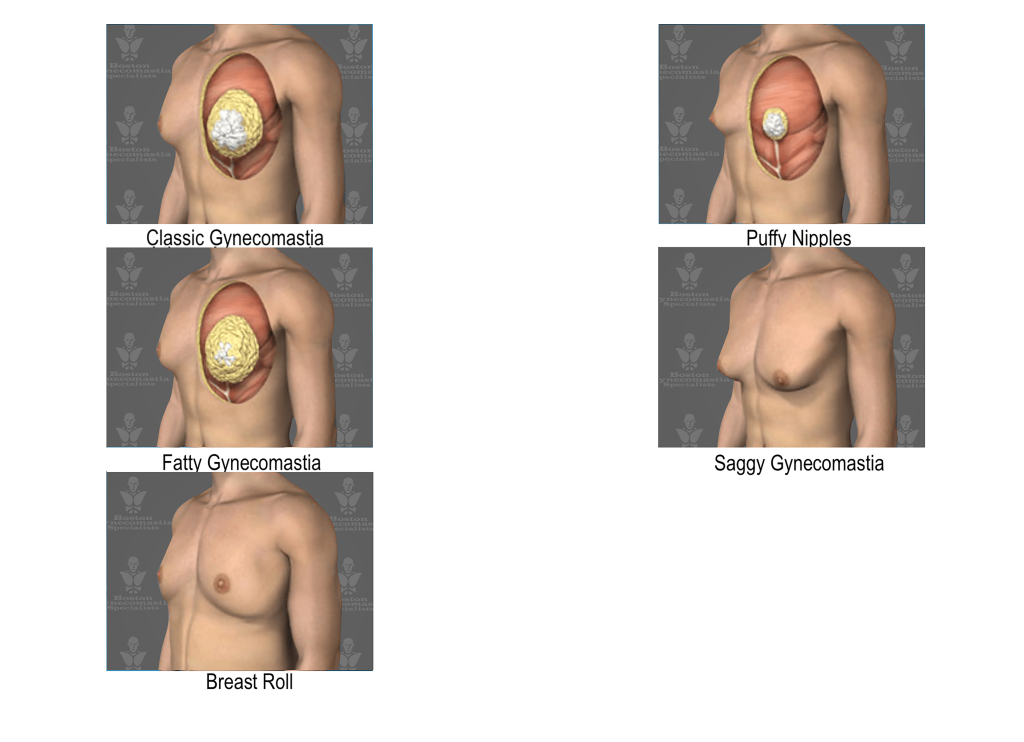
There are typically three primary causes for each type male breast enlargement. There can be one issue present or a combination.
- Excess breast tissue
- Excess fat
- Excess skin
- A combination of the above
During your gynecomastia consultation, Dr. Ishoo will evaluate your chest and inform you of which components are present and what type of surgery is necessary for correction. The exact cause of male breast enlargement is usually difficult to pin-point. It is actually much easier to correct it than to determine the cause, especially since the condition cannot be reversed by identifying and eliminating the cause of gynecomastia. Some men have taken certain medications or anabolic steroids, which is a frequent reason for adult on-set gynecomastia. For others, their enlarged male breasts occurred during puberty when hormones are fluctuating, and it never resolved on its own.
Classic Gynecomastia
The most common type of gynecomastia is called classic gynecomastia. This is when the enlarged breast is caused by a combination of excess breast tissue and an excess of fatty tissue.

If you look at the picture above on the right, you will notice with class gynecomastia the enlarged breast rounds out at the bottom. The picture of an “ideal” chest on the left shows a more defined horizontal line beneath the chest. The roundness is caused by the presence of excess breast tissue, which prevents the underlying pectorals major muscle to show through. The pectorals major muscle is what creates this horizontal line. The excess breast tissue hangs downward, or sags, in a more round or tear drop appearance.

The oblique view above is a very good representation of the change in shape of the male breast when gynecomastia is present. From this angle, you can see the increased projection of the chest especially at and below the nipple. In most cases, the distance from the bottom of the areola to the chest fold is greater than it would be with an “ideal” chest. When classic gynecomastia is surgically corrected, the skin covering this greater distance usually snaps back in a younger male chest. Unfortunately, in older men it may not due to aging of the skin and loss of elasticity. If the skin does not retract back as much as a patient would like, it can be corrected in a minor, secondary procedure under local anesthesia.

In the above picture, you will notice that the nipple and areola are still flush with the surrounding skin. This is what classifies this as Classic Gynecomastia. If the areola and nipple were protruding outward and not lying flat with the skin, this would be considered a case of “Puffy Nipple.”

In the diagram above, you can see that Classic Gynecomastia is a combination of excess breast tissue (white) and excess fat (yellow). In most cases, the excess breast tissue is located under the nipple and it can be felt by pinching the tissue underneath the nipple. It will feel firm and a rubbery or squishy.
It is important to understand that EVERY man has some breast tissue located under the nipple. Only if you feel you have an excess of this tissue, and the appearance of your chest has changed, should you consider surgical options.
In the side view below, you notice the excess fat is located under the breast tissue and dispersed within it as well. This excess fat usually spreads out over a larger area in comparison to the “ideal” chest. You can see how it causes the chest to protrude outward and round out below the areola.
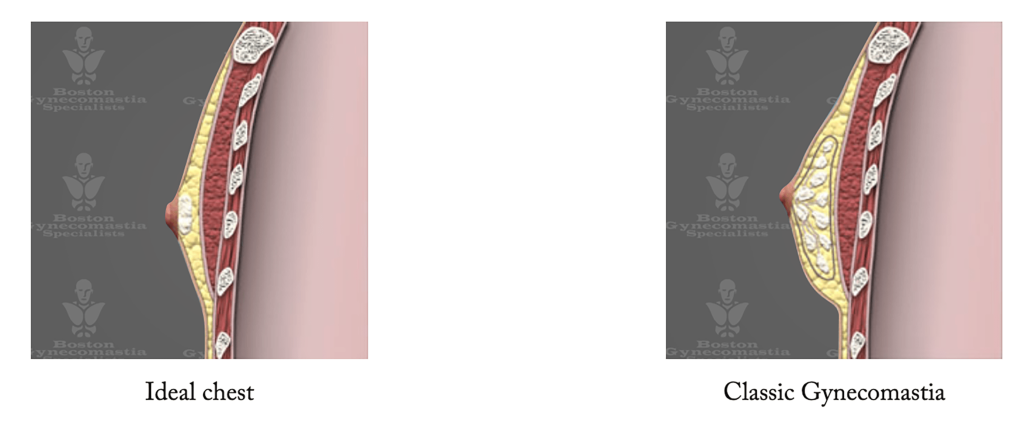
Puffy Nipple
Puffy Nipples are a very common type of gynecomastia Dr. Ishoo sees in Boston, Cambridge, Massachusetts, and New England. Puffy nipples differ from Classic Gynecomastia in that the nipple and areola are cone-shaped, causing the areola to protrude and appear “puffy.” With an ideal chest, the areola lays flat with the surrounding chest skin. When “puffy nipples” are present, the areola projects outward. Many men complain that their protruding nipples become worse in warm and hot temperatures. Oftentimes, men are unable to wear light-colored or thin shirts because the puffy nipples show through, causing them embarrassment and humiliation.
Most of the patients Dr. Ishoo sees with puffy nipples are thin and fit; however, some may have puffy nipples on top of classic gynecomastia. Men with puffy nipples and other symptoms of gynecomastia tend to become very frustrated because no amount of diet and exercise can improve or resolve the issue.

What causes Puffy Nipples in Men?
How to Treat Puffy Nipples
Unlike Classic Gynecomastia, puffy nipples typically do not have a fatty component. When excess breast tissue alone is the problem, liposuction is not an option because it can only remove fatty tissue.
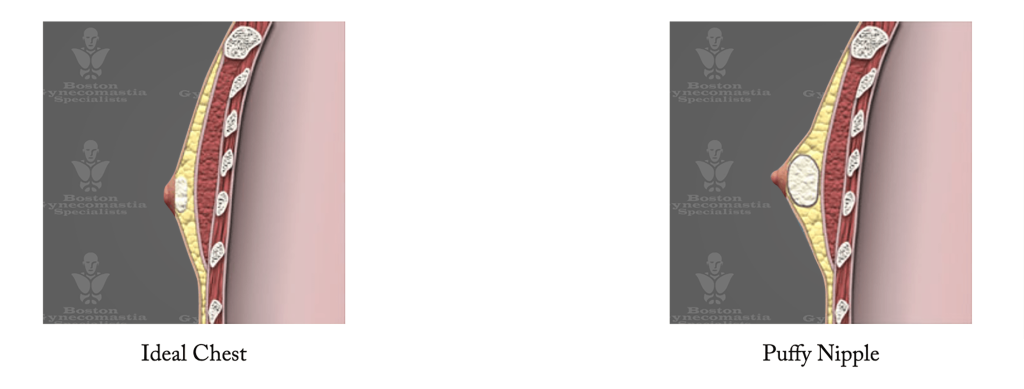

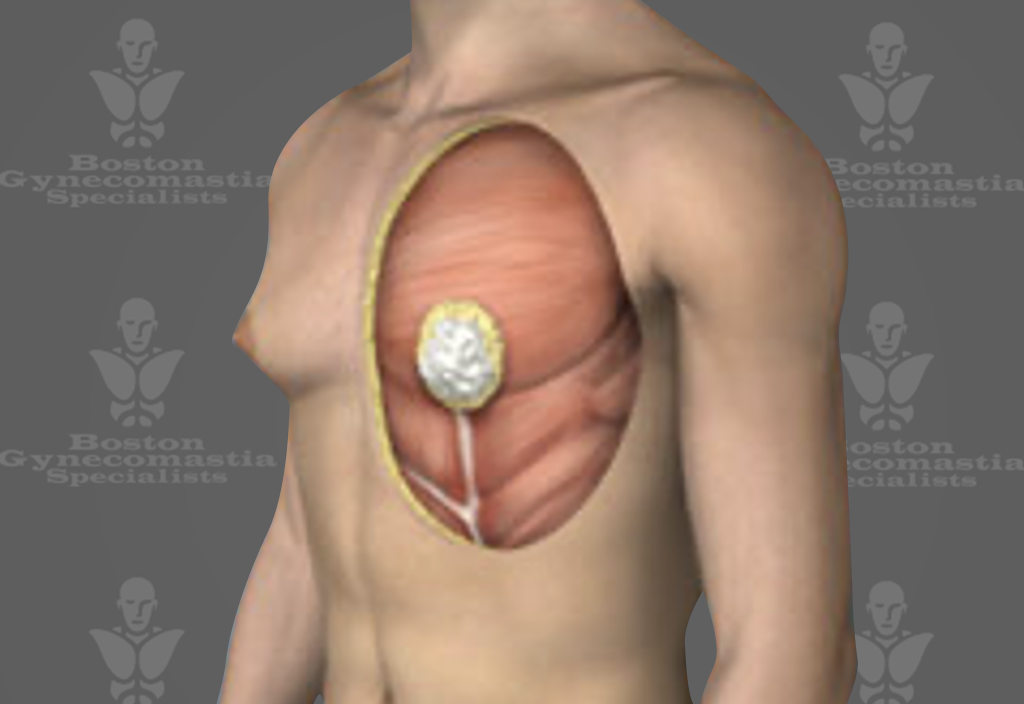
The cut-out view above shows the puffy nipple takes on a cone shape appearance. There is also a lack of fat, which is why the chest doesn’t round out like it does with Classic Gynecomastia. If fat alone was removed with liposuction, the nipple will become even more cone shaped. This is why breast tissue must also be removed with a minimally invasive procedure such as PEXsculpt / CHESTsculpt, so the area can begin to take on a flush appearance with the surrounding skin.
Fatty Gynecomastia
Fatty Gynecomastia is also sometimes referred to in the medical community as Pseudo-Gynecomastia.
The “definition” for gynecomastia that is primarily caused by excess fat is called Pseudo-Gynecomastia. Weight loss is typically recommended as the best solution for Fatty Gynecomastia, however in some cases diet and exercise is not enough. This is frequently the case when men have “love handles,” as well as fatty gynecomastia or pseudo-gynecomastia, because the combination of these two areas do not respond well to weight loss. Even when a man is at an ideal body weight, the body can still accumulate excess fat in these areas. Weight loss is still the recommended first option prior to pursuing surgical options.
Will liposuction alone work or do I need to have breast tissue removed?
In Dr. Ishoo’s experience this tends to be the most common question asked by patients who have done their research on fatty gynecomastia. The answer will vary from surgeon to surgeon. Some surgeons will tell you liposuction alone will take care of the problem. Others believe that breast tissue removal is also necessary. The truth is: It depends!
View the pictures below.

The Main Differences Between Classic and Fatty Gynecomastia
In the above pictures, the main differences between Classic Gynecomastia and Fatty Gynecomastia is demonstrated. The right side of each picture is virtually identical. The gynecomastia looks essentially the same on the outside. Now take a look at the cut-out view on the left side of each chest. Notice the Fatty Gynecomastia has much more fatty tissue (represented in yellow) than Classic Gynecomastia. You will also notice more glandular tissue (shown in white) with Classic Gynecomastia versus Fatty Gynecomastia. You can see that although the overall shape appears to the same, the underlying causes are not identical. This is the reason some types of gynecomastia can only be determined at the time of surgery, which in turn determines what surgical approach should be used.
Liposuction alone works well to eliminate Fatty Gynecomastia, but leaves excess breast tissue behind, which causes Classic Gynecomastia. Removing excess fat from Classic Gynecomastia may turn the chest into a smaller chest with Puffy Nipples. This is why it’s important to seek out an experienced gynecomastia surgeon. If the gynecomastia is not treated appropriately, it could result in continued issues after surgery.

Classic Gynecomastia is represented on the left. Notice the amount of fatty tissue in yellow. After liposuction you will see a dramatic decrease in the amount of fat, however now the breast tissue is exaggerated. This is now creating a “Puffy Nipple” appearance as shown on the right.
Notice on the profile view below that Fatty Gynecomastia has very little, if any, breast tissue. Liposuction alone can at times be effective in treating this type of gynecomastia, but it must be done properly. Fatty tissue is fibrous and quite difficult to remove. The fatty tissue in the chest area is much more resistant to removal than other areas of the body.
Saggy Gynecomastia
Saggy gynecomastia is another sub-component seen with enlarged male breasts. We have discussed different types of gynecomastia based on the possible reasons for male breast enlargement, but there still lies another problem, which is important to be aware of and to understand. Saggy gynecomastia is when a patient has significant excess skin causing the areola and nipple to drop downward and sit on the lower portion of the chest. This type of gynecomastia isn’t as common, because it is typically only seen in patients who have experienced significant weight loss.
To review, there are 3 main causes of gynecomastia:
- Excess breast tissue
- Excess fat
- Excess skin
Excess skin introduces a higher level of complexity when it comes to gynecomastia surgery, because skin must be removed. In order for this to be done properly, a donut shaped incision is made around the entire areola, followed by removal of excess skin from above and sometimes below the areola. This procedure raises the nipple/areola and also tightens the skin. See how this is done in the pictures below:
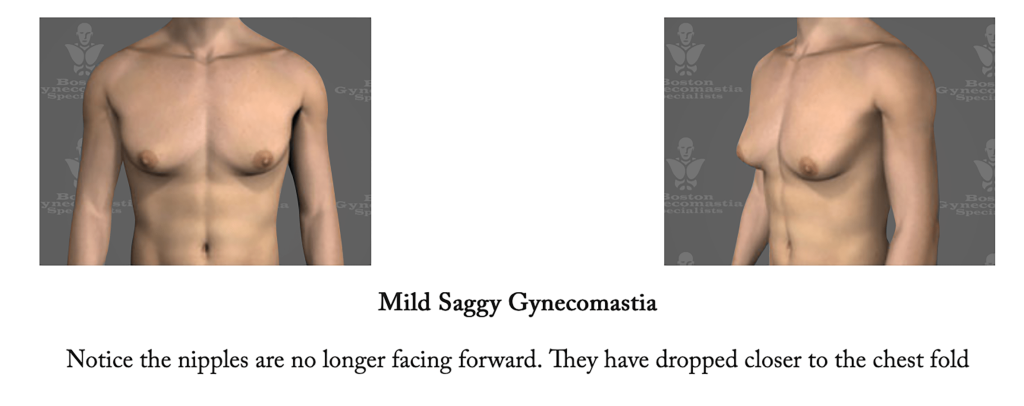
With an “ideal” chest, the nipple usually sits 4-6 cm above the chest fold. When Saggy Gynecomastia is present, the nipple drops down near the chest fold and can even go below this fold in very severe cases. As men age or if they have poor skin quality, mild to moderate cases of Saggy Gynecomastia will usually be seen. The more severe cases are usually present after massive weight loss. This is especially with gastric bypass or Lap Band surgery.
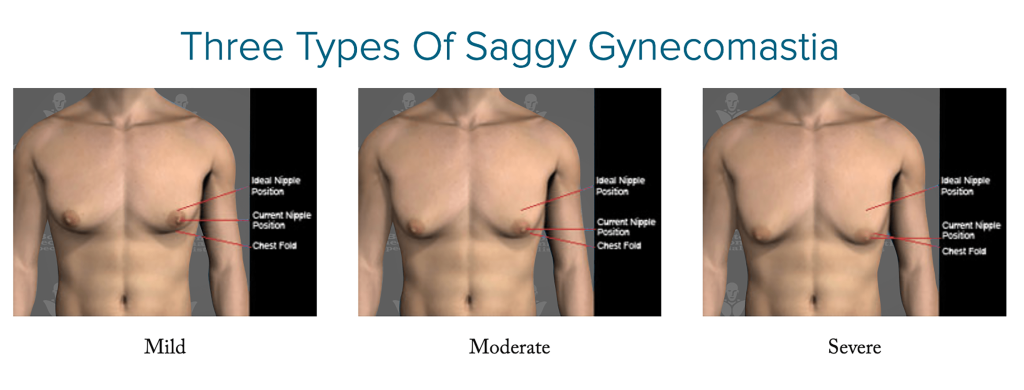
When mild saggy gynecomastia is present, the nipples may be between 2-3 cm above the chest fold. Younger patients have better odds that the skin will snap back after the excess volume is removed. With older men, loss of skin elasticity can compromise the ability for the skin to tighten to the degree one would like to see. Skin quality is the main issue here. The key is determining if the skin should be removed through a donut incision with mild gynecomastia cases.
Dr. Ishoo does not perform the donut incision on his younger patients with mild saggy gynecomastia. They usually don’t need it, because their skin will tighten on it’s own. It is key that a patient commits to wearing a compression garment following surgery to ensure the best result possible. In most older patients, a donut lift may be optimal, but this will depend on the outcome the patient desires from surgery. If the donut incision is recommended, the good news is that the incision is very small and typically does not leave a scar that can be detected. By performing the donut lift, the nipple and areola are moved back into the ideal position and the redundant skin is tightened. This creates a more youthful appearance of the chest. Even though Dr. Ishoo will give his recommendation, ultimately the decision to have a donut lift is up to the patient. Being well informed of what the results will be with and without the donut lift is key to making the best decision possible.
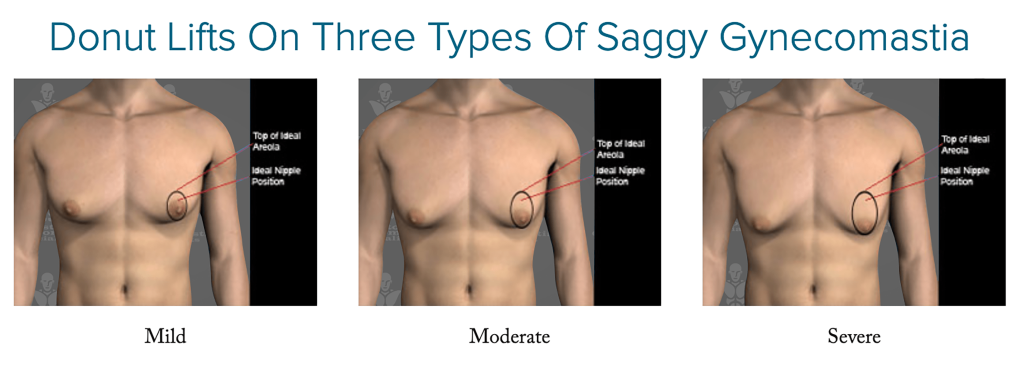
The 3 types of Saggy Gynecomastia are determined by the position of the nipple/areola. In mild cases the nipples are typically located 2-3cm above the chest fold. In moderate cases the nipples are located between the chest fold and approximately 2 cm above it. And, with severe cases of saggy gynecomastia, the nipples hang below the chest fold. With moderate sagginess, a donut lift is usually recommended in order to properly reposition the nipple/areola and to tighten the relaxed chest skin.
When a donut lift is a performed there is a “purse string” affect that takes place. Imagine the suture as a purse string. Now imagine you want to close or tighten the closure of your purse. You would see some rippling around the edges of where the purse closed up. This same thing takes place when the sutures are tightened/closed around the areola on the circle or donut shape. If rippling occurs, it will subside within a few months and flatten out in most cases, depending on what degree of sag was present. With mild sagginess, there could be a minimal amount of rippling, but it will go away quickly. With moderate sagginess, there will usually be some degree of rippling, however it will resolve over time. Patience is key during this healing process. The incision placement of a donut lift falls within the margin of the darker colored areola, thus allowing them to be very well hidden.
Severe Gynecomastia is not always treatable with a donut lift alone. The donut lift in these cases is much larger in size, which can cause persistent rippling, especially if the procedure is performed by a surgeon with little experience. To avoid the potential for long-term rippling, most plastic surgeons will use the same approach as they would a female breast lift by performing a full breast lift. A full breast lift requires an anchor type incision that goes around the areola, down the middle of the breast to the chest fold, and then horizontal within the chest fold.
Dr. Ishoo believes most men are not comfortable with the extensive incisions associated with a full breast lift. Therefore, he traditionally performs the largest donut lift as safely possible based on his experience performing gynecomastia surgery. If a patient still has remaining excess skin 6 months or so following the surgery, Dr. Ishoo will advise a secondary skin tightening procedure to correct it. In these cases he performs only the horizontal incision located within the chest fold, avoiding the vertical scar down the middle of the breast. Again, seldom do patients have severe cases of saggy gynecomastia, as it is typically seen after massive weight loss.
Breast Roll
 Another component of gynecomastia, which is rarely discussed, is the Male Breast Roll. This is an accumulation of fat around the outer part of the chest, which can also be present under the arm and toward the back. A male breast roll is frequently seen in gynecomastia patients that are overweight. Tightening the chest alone and leaving the breast roll will look unusual and perhaps worse. It is a routine practice of Dr. Ishoo to reduce or if feasible, remove a man’s breast roll during his standard gynecomastia procedure. In doing so, optimal result is achieved and the patient is much happier with the appearance of his chest. If the male breast roll is not addressed during surgery, the result with be a flat chest with an exaggerated roll extending from the armpit area and likely to the back. This does not create an attractive 360 degree appearance.
Another component of gynecomastia, which is rarely discussed, is the Male Breast Roll. This is an accumulation of fat around the outer part of the chest, which can also be present under the arm and toward the back. A male breast roll is frequently seen in gynecomastia patients that are overweight. Tightening the chest alone and leaving the breast roll will look unusual and perhaps worse. It is a routine practice of Dr. Ishoo to reduce or if feasible, remove a man’s breast roll during his standard gynecomastia procedure. In doing so, optimal result is achieved and the patient is much happier with the appearance of his chest. If the male breast roll is not addressed during surgery, the result with be a flat chest with an exaggerated roll extending from the armpit area and likely to the back. This does not create an attractive 360 degree appearance.
Options for Addressing Male Breast Roll
Liposuction Alone
Liposuction alone – If the patient is young with tight skin, liposuction alone will be adequate.
Liposuction with Breast Roll Excision
Liposuction with breast roll excision – If the skin quality is not good, i.e. stretch marks, history of significant weight loss, or over 40, typically the breast roll will need to be removed with liposuction and skin excision. This will achieve an ideal contour and result that will last for decades.
It is important to know that any incisions made will continue to fade over time, whereas the male breast roll will get worse over time if not addressed at the time of surgery.
Example of a Breast Roll
Notice in the picture above, and in the one below, how the excess fat begins on the outer part of the chest and continues around toward the back.
_____________________________________________________________
The Boston Gynecomastia Specialists is the premier Greater Boston Gynecomastia Center of Excellence. Our primary focus is on providing outstanding care throughout every step of your journey, from the first consultation to your full recovery. We recognize and appreciate the confidence you have in us and are unwavering in our commitment to maintaining the utmost level of patient care. Led by Dr. Edwin Ishoo, a highly skilled, board-certified surgeon with expertise and over 30 years’ experience in Male Breast Reduction, our dedicated team is fully committed to ensuring the best possible surgical outcomes tailored for each individual. Recognizing that every man is unique, we personalize our approach to meet your specific condition, needs and expectations. We welcome you to take that first step to achieving the transformation you have been imagining and contact the Boston Gynecomastia Specialists, the leading Gynecomastia Center in Boston, to meet with Dr. Ishoo for your personalized, in-person consultation and have your questions answered. Let us take the gynecomastia concern off your chest in a day and off your mind forever!

